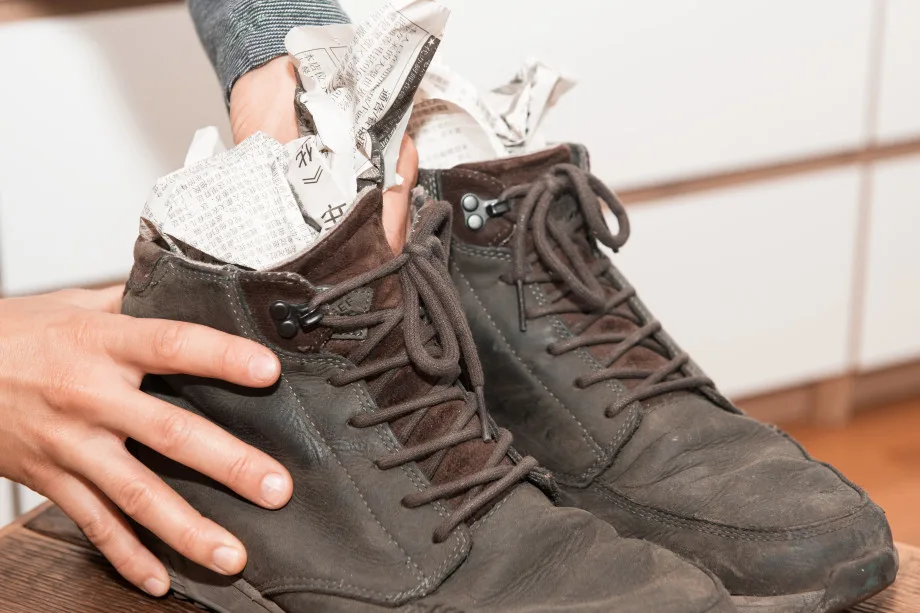
Radiator or newspaper? How to take better care of wet winter boots
Berlin (dpa) - On these grey winter days it's tempting to behave like a kid, jumping excitedly into puddles and playing in the snow instead of carefully avoiding both because your shoes might get dirty.
In fact, you should go right ahead and enjoy the messy winter, because winter shoes can easily cope - all you need to do is know the following care tricks.
What's the best way to dry out wet shoes?
"Under no circumstances should they be placed on the heating or subjected to a hairdryer. They will become brittle and cracked," warns Claudia Schulz of the German Shoe and Leather Goods Industry Association.
Some sheets of newspaper or kitchen roll stuffed inside the shoe will help absorb the moisture. But then they need time to dry, of course.
Only when there is no more moisture can the shoes - depending on the material - be treated with a shoe polish or other care products. These must be allowed time to work, after which the shoes can be polished and then applied with a protective spray.
Is it true you shouldn't wear shoes every day?
It is indeed sensible to have several pairs of changeable winter boots.
"Even if the shoes haven't got very wet, you should always wait a day or two before wearing them again," says Schulz. This is actually a general rule that applies to all closed shoes year round.
Given that up to a shot glass full of moisture collects in a pair of shoes every day, it must be allowed to evaporate.
"Leather shoes are particularly in need of this resting time. They need up to 20 hours to dry," says Arno Carius, President of the Central Association of the German Shoemaking Trade.

If your winter boots are damp or wet, don't put them on a radiator. A bit of crumpled-up newspaper stuffed into the shoe will help absorb the moisture (Source: Robert Guenther/dpa via Reuters)
Using a shoe tree when the shoes are not being worn is also a good idea. That way you avoid damage and creasing. The shoe tree should ideally be made of unvarnished wood and should also be the right size.
Under no circumstances should shoes be placed in plastic bags, as this is a certain way to encourage the formation of mould. Shoe bags made of cotton or linen are a much better alternative.
"Shoeboxes are also practical," says Schulz. "If you stick photos of the shoes on the fronts, no pair will be forgotten."
WATCH BELOW: HOW TO REALLY CLEAN SALT STAINS OFF BOOTS, MATS AND CLOTHES (SIMPLE METHOD)
SEE ALSO: Winter driving tips from a world rally champion
How do I stop getting my feet wet?
No shoe should be left outside in winter without first being sprayed with a protective coating product - regardless of whether the shoes are new or have been worn for a long time.
The coating keeps water and dirt out better. Depending on the wear and how wet it is, spraying should be repeated from time to time.
"The care products normally offered at shoe shop counters make sense if it is a high-quality product," says Schulz.
A tip for use: care sprays should never be used indoors, but only outdoors.
What is the best way to remove dirt?
Surprise surprise, good old shoe polish is not always the answer and is actually a no-go for many materials, according to the experts.
"Shoe polish is generally not suitable for shoes made of synthetic materials. It would leave unsightly stains," says Carius. "Such shoes need to be cleaned with special sprays or cleaning foams."
Suede and leather should also not be cleaned with shoe polish.
Marks left behind by snow are a challenge because they often contain salt that's been spread on the road. Although the marks can be dissolved with water and a mild detergent, this is not always enough.
"For stubborn stains, a mixture of two parts water and one part mild vinegar helps," Carius says. "If you apply it carefully, it even works on leather shoes."
Reporting by: Katja Fischer in Berlin. Editing by: Tom Masters









